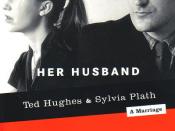"There is more to poetry than moods and feelings."
With the use of various language techniques, poetry reveals to its audience many other things, other than moods and feelings. Poems allow its authors to ventilate their own emotions about certain influential issues occurring in their lives. They can also recount pivotal experiences and attitudes towards particular (often societal) affairs. Psychologically, a poem can reveal character, personality and mentality. Therefore, if a piece of poetry was studied carefully enough, the audience would be able to uncover many deep and personal aspects of the poet, as well as learning of their opinions. Sylvia Plath's poem Cut is an excellent example - it successfully and effectively conveys all of the aforementioned information to the audience.
The poem Cut written by Sylvia Plath is a reflection of her mental state and schizophrenic tendencies that she suffered during her life. The irregular beat and free verse structure of the poem represents her instability.
The very first line "What a thrill -" describes her foremost response to cutting her thumb in the kitchen. Plath sees the cut as a form of emotional release, shown to us by her use of the emotive word, "thrill". She is excited by this pleasurable semi-deliberate self mutilation. She describes her blood rushing from the wound as "red plush". In literal terms, plush is a soft, thick, luxurious carpet - her metaphor suggests that she is luxuriated by the fact she is bleeding from her cut.
Sylvia Plath uses assonance very effectively in her poem Cut. It is used in assisting visual descriptions, such as in "sort of a hinge of skin" - her reference is to a common door hinge holding no dramatic qualities. However, this is immediately followed by a far more sinister image. Her deeply disturbed mind...



Sylvia
Sylvia Plath is one of my favorite poets. Your analysis of her poetic technique is very good. Nice work.
3 out of 3 people found this comment useful.